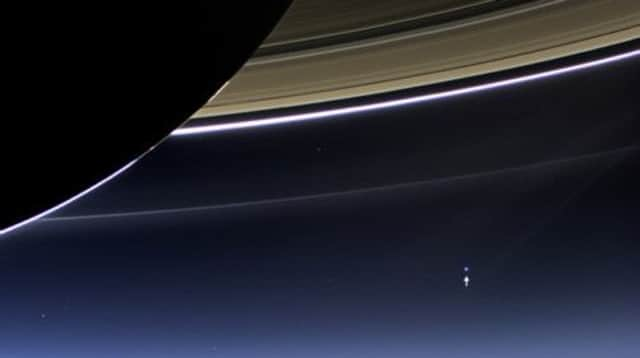Earth, a speck in space snapped from 900m miles


Setting in context mankind’s place in the universe, the image shows Earth as a glowing blue beacon, and the Moon as a tiny pinprick beside it, with the mighty bulk of Saturn and its rings in the foreground.
The picture was taken on 19 July, when people around the world were encouraged by Nasa to wave at Saturn at the time that the interplanetary portrait was taken. It is only the third time that Earth has been photographed from the outer reaches of the Solar System.
Advertisement
Hide AdAdvertisement
Hide Ad“We can’t see individual continents or people in this portrait of Earth, but this pale blue dot is a succinct summary of who we were on 19 July,” said Linda Spilker, one of the Cassini mission’s scientists at Nasa’s Jet Propulsion Laboratory in Pasadena, California.
“Cassini’s picture reminds us how tiny our home planet is in the vastness of space and also testifies to the ingenuity of the citizens of this tiny planet to send a robotic spacecraft so far away from home to study Saturn and take a look-back photo of Earth,” she added.
The further a spacecraft travels, the closer Earth appears to the Sun. Training sensitive camera lenses on Earth from such a distance would ordinarily risk catastrophic damage from the light, in the same way as a human retina can also be blinded by the brilliance of the Sun.
For 15 minutes last Friday, however, Cassini’s position was such that Saturn eclipsed the Sun, allowing scientists to transmit the command for it to swivel its cameras to look back at where it had come from. On the same day, Nasa’s Messenger spacecraft – the first probe to orbit Mercury – also snapped Earth from a distance of 61 million miles.
“That images of our planet have been acquired on a single day from two distant solar system outposts reminds us of this nation’s stunning technical accomplishments in planetary exploration,” said Sean Solomon, the Messenger mission’s principal investigator at Columbia University’s Lamont- Doherty Earth Observatory in New York state.
He added: “Because Mercury and Saturn are such different outcomes of planetary formation and evolution, these two images also highlight what is special about Earth. There’s no place like home.”
The Cassini mission launched from Florida in 1997, arrived in Saturn’s orbit in 2004 and is due to end its mission in 2017 with a fact-finding fall through the giant planet’s atmosphere.
There have been just two previous images of Earth taken from the outer Solar System; one by Cassini in 2006, taken from 926 million miles away, and the other in 1990 by Nasa’s Voyager 1 spacecraft.
Advertisement
Hide AdAdvertisement
Hide AdVoyager was four billion miles from Earth at the time, making it the most distant snapshot ever taken and earning it the caption of the Pale Blue Dot from American astrophysicist Carl Sagan. “Look again at that dot. That’s here. That’s home. That’s us,” he wrote.